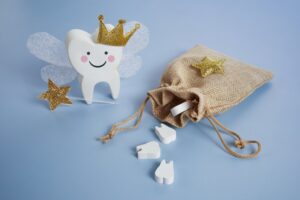
Whether you plan to or not, as a parent, you probably will choose to share little “white lies” with your child at some point to bring them hope, help them feel excited for growth, or simply entice them to make better choices. Next to Santa Claus and the Easter Bunny, you have the Tooth Fairy, who is attached to a special rite of passage—losing baby teeth. While this scenario, especially if blood is involved, could be frightening for a young child, the kind Tooth Fairy transforms fear into laughter and excitement. How did this tradition and myth start? Does every culture around the world celebrate baby tooth loss the same way? Find out here!
Oldest Traditions with Baby Tooth Loss
Although the Tooth Fairy myth shared among most families in the United States today didn’t show up until the 1900s, early Norse records indicate that necklaces of the warriors’ lost baby teeth were considered good luck in battle.
During the Medieval Era in Europe, tooth loss possessed a darker side. Instead of a friendly, cute fairy coming to exchange a tooth for money or a gift, it was said that if witches obtained the baby tooth, they could control a person’s body. Back then, most children hid and buried their lost dentition to protect themselves. Fortunately, since then, most cultures have created lighter and happier traditions associated with growing up.
Raton de los Dientes or the “Tooth Mouse”
Although this figure goes by many names throughout Spanish-speaking cultures, in these countries, a small mouse typically collects teeth. Children would place their teeth in a glass of water, which the Tooth Mouse would drink and take the small piece, replacing it with a gift or money.
Similarly, in France, Switzerland, Belgium, and Morroco, “La Petite Souris” is the name of the mouse who retrieves your child’s tooth from under their pillow and leaves a goodie behind.
Throw a Baby Tooth, Make a Wish
In several countries, baby teeth are offered as tokens for better, stronger teeth to come in. Think of them as coins you would throw into a fountain for a wish. In Korea and Brazil, baby teeth are traditionally tossed onto the roof for a bird to take and bring them a strong adult tooth. In Egypt, Iraq, and other Middle Eastern countries, baby teeth are thrown into the air, asking the sun to bestow a healthy replacement.
Hold onto Baby Teeth
In Lithuania, lost baby teeth are kept for making a necklace or other memorabilia from childhood, but Turkish children are taught that the location where they bury their tooth may affect their future. For instance, if the child hides it near a certain type of business or landmark, they may enter a related field professionally later in life.
Regardless of where you from or what “white lie” you tell your child about tooth loss, the Tooth Fairy should replace a possibly scary moment with a smile, enjoy the magic and mystery of childhood, and to encourage kids to take excellent care of their oral health. So, when it comes time for your child’s first wiggly tooth, feel free to have fun with it!
About the Practice
Wash Park Pediatric Dentistry takes dental care for kids to the next level. With Dr. Patrick Bowman and Dr. Kathleen Waguespack, our two board-certified pediatric dentists on staff, our team is particularly qualified to make visits and procedures more enjoyable for kids up to age 18, including those with special needs. Even if you have an infant, we can make dental visits starting around their first birthday productive and helpful, explaining their future oral development and providing tips for at-home care. To schedule an appointment, contact our Denver office by calling 720-647-6310 or clicking on this link.
